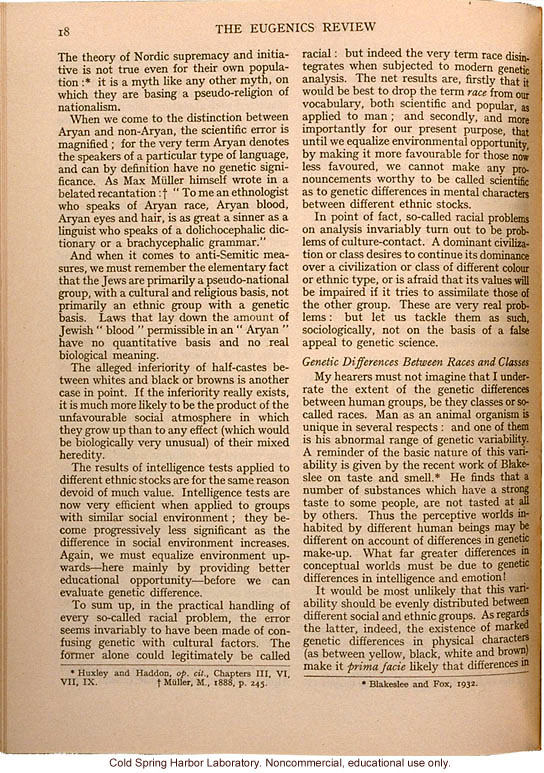"Eugenics and Society" (The Galton Lecture given to the Eugenics Society), by Julian S. Huxley, Eugenics Review (vol 28:1) (7)

"Eugenics and Society" (The Galton Lecture given to the Eugenics Society), by Julian S. Huxley, Eugenics Review (vol 28:1) (7)
1830. 18 The Eugenics Review The theory of Nordic supremacy is not even true for their own population:* it is a myth like any other myth, on which they are basing a pseudo-religion of nationalism. When we come to the distinction between Aryan and non-Aryan, the scientific error is magnified; for the very term Aryan denotes the speakers of a particular type of language, and can by definition have no genetic significance. As Max M[umlaut over 'u']ller himself wrote in a belated recantation:[dagger] "To me an ethnologist who speaks of Aryan race, Aryan blood, Aryan eye and hair, is as great a sinner as a linguist who speaks of a dolichocephalic dictionary or a brachycephalic grammar." And when it comes to anti-Semitic measures, we must remember the elementary fact that the Jews are primarily a pseudo-national group, with a cultural and religious basis, not primarily an ethnic group with a genetic basis. Laws that lay down the amount of Jewish "blood" permissible in an "Aryan" have no quantitative basis and no real biological meaning. The alleged inferiority of half-castes between whites and blacks or browns is another case in point. If the inferiority really exists, it is much more likely to be the product of the unfavourable social atmosphere in which they grow up than to any effect (which would be biologically very unusual) of their mixed heredity. The results of intelligence tests applied to different ethnic stocks are for the same reason devoid of much value. Intelligence tests are now very efficient when applied to groups with similar social environment; they become progressively less significant as the difference in social environment increases. Again, we must equalize environment upwards - here mainly by providing better educational opportunity - before we can evaluate genetic difference. To sum up, in the practical handling of every so-called racial problem, the error seems invariably to have been made of confusing genetic with cultural factors. The former alone could legitimately be called racial: but indeed the very term race disintegrates when subjected to modern genetic analysis. The net results are, firstly that it would be best to drop the term [italics]race[end italics] from our vocabulary, both scientific and popular, as applied to man; and secondly, and more importantly for our present purpose, that until we equalize environmental opportunity, by making it more favourable for those now less favoured, we cannot make any pronouncements worth to be called scientific as to genetic differences in mental characters between different ethnic stocks. In point of fact, so-called racial problems on analysis invariably turn out to be problems of culture-contact. A dominant civilization or class desires to continue its dominance over a civilization or class of different colour or ethnic type, or is afraid that its values will be impaired if it tries to assimilate those of the other group. These are very real problems: but let us tackle them as such, sociologically, not on the basis of a false appeal to genetic science. [italics]Genetic Differences Between Races and Classes[end italics] My hearers must not imagine that I underrate the extent of the genetic differences between human groups, be they classes or so-called races. Man as an animal organism is unique in several respects: and one of them is his abnormal range of genetic variability. A reminder of the basic nature of this variability is given by the recent work of Blakeslee on taste and smell.* He finds that a number of substances which have a strong taste to some people, are not tasted at all by others. Thus the perceptive worlds inhabited by different human beings may be different on account of differences in genetic make-up. What far greater differences in conceptual worlds must be due to genetic differences in intelligence and emotion! It would be most unlikely that this variability should be evenly distributed between different social ad ethnic groups. As regards the latter, indeed, the existence of marked genetic differences in physical characters (as between yellow, black, white and brown) make it [italics]prima facie[end italics] likely that differences in [left side hairline column-width rule over footnotes] [footnotes]*Huxley and Haddon, [italics]op. cit.[end italics], Chapters III, IV, VII, IX. [dagger] M[umlaut over 'u']ller, M., 1888, p. 245. [right side hairline column-width rule over footnote] [footnote] *Blakeslee and Fox, 1932. [end]
- ID: 11745
- Source: DNALC.EA


